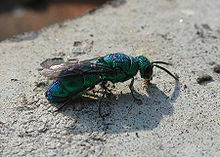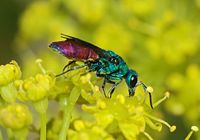- Cuckoo wasp
-
Cuckoo Wasps 
Scientific classification Kingdom: Animalia Phylum: Arthropoda Class: Insecta Order: Hymenoptera Suborder: Apocrita Superfamily: Chrysidoidea Family: Chrysididae Subfamilies Amiseginae
Chrysidinae
Cleptinae
LoboscelidiinaeCommonly known as cuckoo wasps, the Hymenopteran family Chrysididae is a very large cosmopolitan group (over 3000 described species) of parasitoid or cleptoparasitic wasps, often highly sculptured, with brilliantly colored metallic-like bodies (thus the common names jewel wasp, gold wasp, or emerald wasp are sometimes used). They are most diverse in desert regions of the world, as they are typically associated with solitary bee and wasp species, which are also most diverse in such areas.
Members of the largest subfamily, Chrysidinae, are the most familiar; they are generally cleptoparasites, laying their eggs in host nests, where their larvae consume the host egg or larva while it is still young, then consuming the provisions. Chrysidines are distinguished from the members of other subfamilies in that most can curl into a defensive ball, in a process known as conglobation. This ability is shared with pill bugs, pill millipedes (which are often mistaken for pill bugs), and armadilloes. Members of the other subfamilies are parasitoids, of either sawflies or walking sticks, and cannot fold up into a ball.
External links
- Chrysis. net a picture rich and very informative site
- Family Chrysididae - Cuckoo Wasps at Bugguide, images and information.
- Chrysididae Identification Guide An online guide to the Chrysidids of Eastern North America
- Hymis de Images (=Bilder)

This wasp-related article is a stub. You can help Wikipedia by expanding it.

